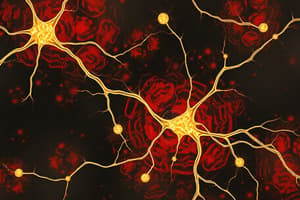Podcast
Questions and Answers
Kaip neuronai perduoda impulsus?
Kaip neuronai perduoda impulsus?
Veikimo potencialas yra nervinis impulsas.
Veikimo potencialas yra nervinis impulsas.
True (A)
Kas yra veikimo potencialas?
Kas yra veikimo potencialas?
Nervinis impulsas
Ką smegenys daro su neuronų siunčiamais signalais?
Ką smegenys daro su neuronų siunčiamais signalais?
Signup and view all the answers
Kūnas kaip visuma yra elektriškai neutralus.
Kūnas kaip visuma yra elektriškai neutralus.
Signup and view all the answers
Kas palaiko teigiamus ir neigiamus krūvius atskirai kūne?
Kas palaiko teigiamus ir neigiamus krūvius atskirai kūne?
Signup and view all the answers
Neuronai gali keisti impulsų ______ arba skaičių.
Neuronai gali keisti impulsų ______ arba skaičių.
Signup and view all the answers
Kas yra pagrindinis neurono signalo perdavimo būdas?
Kas yra pagrindinis neurono signalo perdavimo būdas?
Signup and view all the answers
Sujunkite sąvokas su jų apibrėžimais:
Sujunkite sąvokas su jų apibrėžimais:
Signup and view all the answers
Kokia yra neurono ramybės būsenos įtampa (mV)?
Kokia yra neurono ramybės būsenos įtampa (mV)?
Signup and view all the answers
Veiksmo potencialo stiprumas priklauso nuo dirgiklio stiprumo.
Veiksmo potencialo stiprumas priklauso nuo dirgiklio stiprumo.
Signup and view all the answers
Kaip vadinasi laikotarpis, kai aksono dalis negali reaguoti į jokį kitą dirgiklį?
Kaip vadinasi laikotarpis, kai aksono dalis negali reaguoti į jokį kitą dirgiklį?
Signup and view all the answers
Veiksmo potencialas yra laikinas membranos potencialo ______.
Veiksmo potencialas yra laikinas membranos potencialo ______.
Signup and view all the answers
Koks jonų kanalas pirmiausia atsiveria depoliarizacijos metu?
Koks jonų kanalas pirmiausia atsiveria depoliarizacijos metu?
Signup and view all the answers
Mielininės dangos neturi įtakos neurono perdavimo greičiui.
Mielininės dangos neturi įtakos neurono perdavimo greičiui.
Signup and view all the answers
Kaip vadinamas procesas, kai membranos įtampa trumpam nukrenta žemiau ramybės potencialo?
Kaip vadinamas procesas, kai membranos įtampa trumpam nukrenta žemiau ramybės potencialo?
Signup and view all the answers
Slenkstinė įtampa, kurią reikia pasiekti, kad įvyktų veiksmo potencialas, yra maždaug ______ mV.
Slenkstinė įtampa, kurią reikia pasiekti, kad įvyktų veiksmo potencialas, yra maždaug ______ mV.
Signup and view all the answers
Kas vyksta repoliarizacijos metu?
Kas vyksta repoliarizacijos metu?
Signup and view all the answers
Sujunkite procesą su tinkamu aprašymu:
Sujunkite procesą su tinkamu aprašymu:
Signup and view all the answers
Kas yra įtampa (voltage) neuronų fiziologijoje?
Kas yra įtampa (voltage) neuronų fiziologijoje?
Signup and view all the answers
Ramybės būsenos neurono vidus yra labiau teigiamas (positive) nei išorinė aplinka.
Ramybės būsenos neurono vidus yra labiau teigiamas (positive) nei išorinė aplinka.
Signup and view all the answers
Koks pagrindinis mechanizmas, palaikantis ramybės membranos potencialą neurone?
Koks pagrindinis mechanizmas, palaikantis ramybės membranos potencialą neurone?
Signup and view all the answers
Jei tik keli kanalai atsiveria ir tik šiek tiek natrio patenka į ląstelę, tai sukelia tik nedidelį ______ potencialo pokytį lokalizuotoje ląstelės dalyje.
Jei tik keli kanalai atsiveria ir tik šiek tiek natrio patenka į ląstelę, tai sukelia tik nedidelį ______ potencialo pokytį lokalizuotoje ląstelės dalyje.
Signup and view all the answers
Sujunkite jonų kanalų tipus su jų aktyvavimo mechanizmais:
Sujunkite jonų kanalų tipus su jų aktyvavimo mechanizmais:
Signup and view all the answers
Kas nutinka, kai atsiveria jonų kanalai neurono membranoje?
Kas nutinka, kai atsiveria jonų kanalai neurono membranoje?
Signup and view all the answers
Atsparumas (resistance) yra medžiagos gebėjimas leisti elektrai laisvai tekėti.
Atsparumas (resistance) yra medžiagos gebėjimas leisti elektrai laisvai tekėti.
Signup and view all the answers
Kaip apibūdinamas neuronas, kai jis turi neigiamą membranos potencialą?
Kaip apibūdinamas neuronas, kai jis turi neigiamą membranos potencialą?
Signup and view all the answers
Kad būtų išsiųsti didelio atstumo signalai išilgai aksono, reikia didesnio pokyčio – pakankamai didelio, kad suaktyvintų tuos nuo ______ priklausančius kanalus.
Kad būtų išsiųsti didelio atstumo signalai išilgai aksono, reikia didesnio pokyčio – pakankamai didelio, kad suaktyvintų tuos nuo ______ priklausančius kanalus.
Signup and view all the answers
Kokią įtaką natrio-kalio siurblys turi neurono membranos potencialui?
Kokią įtaką natrio-kalio siurblys turi neurono membranos potencialui?
Signup and view all the answers
Flashcards
Neurono veiksmų potencialas
Neurono veiksmų potencialas
Elektros impulsas, kurį neuronas siunčia kaimyniniams neuronams.
Neurono impulsų dažnis
Neurono impulsų dažnis
Dažnis, kuriuo neuronas siunčia impulsus, skirtingas signalams perteikti.
Veiksmų signalų vertimas
Veiksmų signalų vertimas
Procesas, kai smegenys interpretuoja nervų impulsus.
Elektrinis potencialas
Elektrinis potencialas
Signup and view all the flashcards
Neutro kūnas
Neutro kūnas
Signup and view all the flashcards
Baterijos potekstė
Baterijos potekstė
Signup and view all the flashcards
Nervų impulso galia
Nervų impulso galia
Signup and view all the flashcards
Kraujotakos galios terminas
Kraujotakos galios terminas
Signup and view all the flashcards
Nervenų sinapsė
Nervenų sinapsė
Signup and view all the flashcards
Smegenų interpretacijos procesas
Smegenų interpretacijos procesas
Signup and view all the flashcards
Neurono poilsio membranos potencialas
Neurono poilsio membranos potencialas
Signup and view all the flashcards
Natrio-kalio siurblys
Natrio-kalio siurblys
Signup and view all the flashcards
Elektrocheminis gradientas
Elektrocheminis gradientas
Signup and view all the flashcards
Kanalo tipai: Įtampos, Ligando ir Mechaninio veikimo
Kanalo tipai: Įtampos, Ligando ir Mechaninio veikimo
Signup and view all the flashcards
Graded potencialas
Graded potencialas
Signup and view all the flashcards
Veikimo potencialas
Veikimo potencialas
Signup and view all the flashcards
Poliarizacija
Poliarizacija
Signup and view all the flashcards
Jonų difuzija
Jonų difuzija
Signup and view all the flashcards
Membranų potencialas
Membranų potencialas
Signup and view all the flashcards
Jonų kanalai
Jonų kanalai
Signup and view all the flashcards
Depolarizacija
Depolarizacija
Signup and view all the flashcards
Repolarizacija
Repolarizacija
Signup and view all the flashcards
Hipopoliarizacija
Hipopoliarizacija
Signup and view all the flashcards
Atšalimo periodas
Atšalimo periodas
Signup and view all the flashcards
Slenkstinė įtampa
Slenkstinė įtampa
Signup and view all the flashcards
Myelinizuoti aksonai
Myelinizuoti aksonai
Signup and view all the flashcards
Ranvier mazgai
Ranvier mazgai
Signup and view all the flashcards
Sūkurinė kondukcija
Sūkurinė kondukcija
Signup and view all the flashcards
Veikimo dažnis
Veikimo dažnis
Signup and view all the flashcards
Study Notes
Neuron Communication: An Electrical Overview
- Neurons communicate through electrical impulses, called action potentials, transmitted down axons to neighbouring neurons.
- The strength and speed of the signal remain constant, but the frequency of these signals varies. This fluctuation in frequency allows the brain to interpret different messages and their importance.
- The brain interprets these signals akin to binary code, determining location, intensity, and priority of the received messages.
Electrical Properties of the Body
- The body functions as a system of interconnected batteries; electrically neutral, equal positive and negative charges, but certain areas have more negative or positive charges.
- Membranes separate positive and negative charges to store potential energy.
- Voltage is the measurement of potential energy from separated charges, measured in millivolts (mV) in the human body.
- Membrane potential represents this voltage difference between a cell and its surroundings. The difference between positive and negative charge intensity defines the voltage and the potential energy or magnitude.
- Current is the movement or flow of charge. It is related to voltage and resistance. High resistance materials are insulators (like plastic), and low resistance materials are conductors (like metal).
- Cellular currents represent movement of charged ions through cellular membranes. These membranes are electrically important in creating and controlling the flow of currents that create information processing within the nervous system.
Neuron Resting Potential and Action Potential
- Resting neurons have a negative membrane potential, usually around -70mV, interior of the neuron is more negative than the surrounding extracellular space. This state is known as the resting membrane potential.
- Positive sodium and potassium ions exist in higher concentrations in specific portions of the cell – these create an imbalance with regard to charge and concentration.
- Sodium-Potassium pumps maintain this differential across the membrane, pumping 3 sodium ions out for every 2 potassium ions pumped in, creating a positive external environment.
- This electrochemical imbalance represents a stored energy potential that drives the neuron's signalling processes.
Ion Channels
- Ion channels are membrane proteins mediating ion passage.
- Different types of ion channels:
- Voltage-gated channels open or close in response to changes in voltage across the membrane (e.g., sodium channels open around -55mV)
- Ligand-gated channels open when a specific chemical (neurotransmitter or hormone) binds to them.
- Mechanically-gated channels open in response to physical stretching.
Graded Potential vs. Action Potential
- Graded potentials are small, localized changes in membrane potential.
- Action potentials are large, long-distance signals. An action potential is triggered by enough depolarization to cross the resting threshold.
- To transmit a signal across the neuron efficiently over longer distances, sufficiently strong depolarization, called action potential, need to be triggered to open voltage gated channels.
Depolarization
- A stimulus triggers the opening of sodium channels, allowing sodium ions to rush into the neuron.
- This causes depolarization; the inside of the membrane becomes more positive.
- The threshold for initiating an action potential is approximately -55mV.
Repolarization and Hyperpolarization
- After depolarization, potassium channels open, allowing potassium ions to flow out of the neuron.
- This process, called repolarization, restores the negative membrane potential.
- In some instances the neuron may temporarily hyperpolarize, meaning it becomes more negative than it was originally, before returning to resting state.
Refractory Period
- When a part of an axon is in the midst of an action potential, the axon cannot respond to another stimulus. This is the refractory period.
Action Potential Transmission and Frequency
- Action potentials propagate down the axon due to the chain reaction of sequentially opening sodium channels. This "chain reaction" propagates the action potential.
- Action potential strength (height and amplitude) remains essentially constant for any stimulus above the threshold. Difference between stimuli is reflected in frequency of action potentials.
- Frequency of action potentials reflects intensity of stimulus.
Conduction Velocity and Myelination
- Conduction velocity, or the speed of action potential transmission, varies depending on factors such as myelination of the axon.
- Myelin sheaths, insulating layers on axons, increase the speed of signal propagation by allowing the current to "jump" between gaps in the myelin called Nodes of Ranvier, this is called Saltatory conduction.
Studying That Suits You
Use AI to generate personalized quizzes and flashcards to suit your learning preferences.
Description
Šis klausimynas tyrinėja neuronų komunikacijos mechanizmus, pagrindinius elektrinius impulsus ir kaip jie perduodami kaimyniniams neuronams. Sužinosite apie potencialią energiją jungtyse ir kaip smegenys interpretuoja skirtingus signalus, panašiai kaip dvejetainį kodą.





